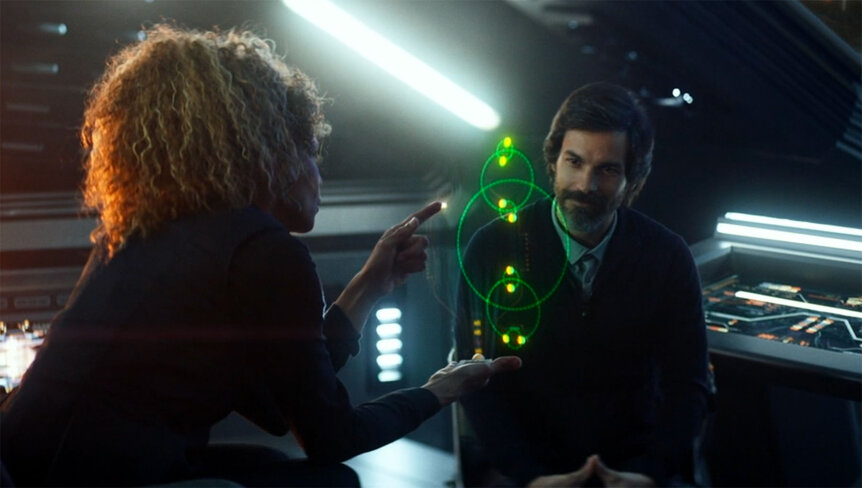Create a free profile to get unlimited access to exclusive videos, sweepstakes, and more!
Cool: Six-star system found. Cooler: Made of three binaries. Coolest: *Eclipsing* binaries.

This deserves a "whoa": Astronomers have found a sextuple (six-) star system where, if you watch it for a few days, every star in it will at some point undergo an eclipse.
Whoa.
Multiple stars are just intrinsically cool: Unlike our Sun, sailing alone through space, multiples are where two or more stars orbit each other in a stable, gravitationally bound system. Half the stars in the galaxy are in multiple systems like that. Most are binaries (two stars orbiting each other) and some in trinaries (three stars). Fewer yet are in higher-order systems.
That's the first thing that makes TYC 7037-89-1 special: It's a sextuplet, a six-star system. It's a little over 1,900 light years away, so a fair distance, but it's bright enough to be detected by TESS, the Transiting Exoplanet Survey Satellite. TESS scans the sky measuring the brightnesses of stars to look for transiting exoplanets, which make mini-eclipses on their host stars, revealing their presence.
But it can find lots of other interesting things, too. TYC 7037-89-1 looks like one star in TESS data, but one that changes its brightness — a variable star. The astronomers who found it look in TESS data for stars that change brightness in a certain way, indicating that they're multiple star systems.
What they looked for are eclipsing binaries: Stars that not only orbit each other, but also ones where we see their orbits nearly edge-on, so that the stars appear to pass in front of on another. When that happens the total light from the pair drops a little bit in a characteristic way. The astronomers set up automated software to look for such stars, and out of nearly half a million they found 100 that appeared to be three-star systems or more.
And that's what brings up the second cool thing about TYC 7037-89-1: It's not just six stars all orbiting every which way, but they're arranged in binaries: One pair of stars orbits another pair of stars, and a third pair orbits them both!
The binary pairs are named A, B, and C in order of brightness, and each star in them is given the number 1 or 2 (again in order of brightness). The two inner binaries are then A (made up of stars A1 and A2) and C (C1 and C2), orbited farther out by the binary B (B1 and B2). A and C are separated by about 600 million kilometers (very roughly the distance of Jupiter from the Sun), taking about 4 years to go around each other — this was determined using archival data from other telescopes, including WASP and ASAS-SN. B orbits them both at a distance of about 38 billion km, taking 2,000 years to complete one period.
And that now brings up the coolest thing about this system: All three pairs of stars are eclipsing binaries! We see all three binary orbits nearly edge-on. A1 and A2 undergo mutual eclipses (A1 eclipses A2, then half an orbit later A2 eclipses A1) every 1.57 days, so they're very close together. C1 and C2 orbit each other every 1.31 days, and B1 and B2 take 8.2 days.
Because each star in any given pair eclipses the other, by measuring how long the eclipse takes as well as other parameters (including taking spectra) we can learn important things like how big the stars are, how hot they are, and more. And this yields another surprise: All three binaries are very similar. They're triplets!
In each, the bigger star is about 1.5 times the diameter of the Sun, slightly hotter, and about 1.25 times the Sun's mass. Also in each, the smaller stars are about the same as each other, too: about 0.6 times the Sun's mass and 0.6 times its diameter. They vary a little, but the point is they're pretty close, which is peculiar.
This sort of system is just ridiculously unlikely. Models of how stars form show that sextuples are far more often made up of two trinary systems orbiting each other, not three binaries. So that's rare enough, but to have all three binaries be seen edge-on seems impossible.
... "seems." In fact it's likely they formed from a swirling disk of material, each star collapsing out of it. Because of that it's actually likely that the three orbital planes of the binaries are the same. Therefore if we see one edge-on, we see all of them edge on, or nearly so. That makes it not as unlikely as you might think that all three are eclipsing.
I'll also note the orbits of the binaries around each other are not edge-on. We see the orbit of A and C around each other from an angle of roughly 40°, even as we see the individual stars in the binaries edge-on. The inclination of the orbit of B around them both isn't well constrained by the observations, though.
Hopefully longer-term study of this system will yield more information about how they formed. We don't really know much about multiple systems like this one, so understanding under what conditions they form would be pretty interesting.
I know, this is headache-inducing. So many orbits, angles, stars… Sometimes nature is complex, and it's hard to keep up. If it helps, I describe a similar fictional system that played a key role in the first season of Star Trek: Picard. And more systems a bit like TYC 7037-89-1 are known; for example CzeV1640 is a quadruple system with two pairs of eclipsing binaries. Nature is complex, but sometimes frugal, reusing the same idea over and again.
But oh my, would I like a ship like Enterprise right now! To be able to see such a thing up close for myself, watch as these six stars — six! — dance around each other…
Strange new worlds indeed.






























